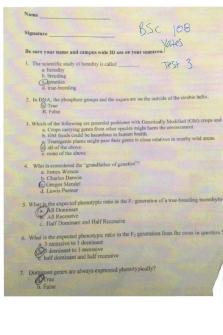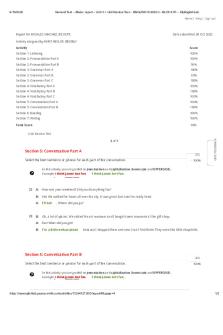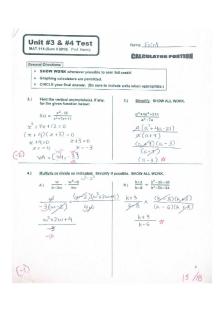Test 3 PDF

| Title | Test 3 |
|---|---|
| Course | Introduction To Sociology |
| Institution | East Carolina University |
| Pages | 1 |
| File Size | 58.4 KB |
| File Type | |
| Total Downloads | 8 |
| Total Views | 138 |
Summary
Fall 2008. Dr. Arunas Juska ...
Description
Test #3 Study Questions Chapter 9: Global Stratification
Define social stratification and explain why it is of sociological significance. Describe the characteristics of slavery and note the uses of slavery in the New World. Identify the features of caste systems and provide examples. Describe an estate system. List the characteristics of a class system and contrast its features with those of other systems of stratification. Identify the basic assumptions of Karl Marx regarding what determines social class. Compare and contrast Karl Marx and Max Weber’s views on class stratification. Describe how functionalists and conflict theorists explain stratification. What are functionalist fallacies? Does functionalism explain or it also justifies inequalities? Explain the mechanisms by which the elite maintains stratification.
Chapter 10. Social Class and poverty in the US.
Explain Mills’ interpretation of the social stratification in the US. What is "power elite" and what is "circulation of the elites"? Provide examples to illustrate these two notions. Explain status inconsistency and discuss its consequences in terms of individual behavior. Examine the consequences of social class in terms of new technology, family life, politics, religion, and illness and health care. Explain, how has income and wealth inequality changed since the late 1970s? Did it increase or decrease? How much wealth does the top 10% of the families in the US own? Which group had lost most in terms of real wages during that period of time? (Blue-collar workers’ wages declined close to 20%) Why does income inequality constitute a social problem? (ethics and political stability). Distinguish between absolute and relative poverty. How does poverty in developed countries differ from poverty in developing countries? How did poverty rate among elderly change since the 1970s? What is feminization of poverty? What factors influenced its growth since the 1970s? Who are "the working poor"? Did their numbers increased or decreased during the 1990s? What factors influenced the growth of the working poor during the 1990s? What is the poverty rate among children in the US? How does poverty rate among children in the US compare with poverty rates of children in other developed countries? What is underclass? What are the major characteristics of the underclass? Indicate how the poverty line is drawn. State the major characteristics of the poor in the United States. How many poor there are currently in the US? How did rate of poverty change in the U.S. since 2000? How long does the poverty last? Contrast short and long-term poverty. Explain and assess individual (individual faults and culture of poverty) versus structural (functionalist and conflict theory) explanations of poverty....
Similar Free PDFs

TEST 3 - test 3 review
- 19 Pages

IBF Test 3 - Test 3
- 1 Pages

Yates Test 3 - Test
- 7 Pages

Test leccion 3 - Test
- 3 Pages

Test 3 - 5 - test
- 2 Pages

Test 3 - 1 - test
- 1 Pages

MCBL Test 3 - Review for test 3
- 6 Pages

Test 3
- 1 Pages

Test 3 quizlet - test 3 study guide
- 10 Pages

AST Test 3 - Test 3 Study guide
- 5 Pages

Unit 3 test - test answers
- 8 Pages

MTM TEST 3 12 - test
- 2 Pages

Unit 3 - Milestone 3 Test
- 3 Pages

Test 3 Review
- 2 Pages

Chapter 3 - test bank
- 45 Pages
Popular Institutions
- Tinajero National High School - Annex
- Politeknik Caltex Riau
- Yokohama City University
- SGT University
- University of Al-Qadisiyah
- Divine Word College of Vigan
- Techniek College Rotterdam
- Universidade de Santiago
- Universiti Teknologi MARA Cawangan Johor Kampus Pasir Gudang
- Poltekkes Kemenkes Yogyakarta
- Baguio City National High School
- Colegio san marcos
- preparatoria uno
- Centro de Bachillerato Tecnológico Industrial y de Servicios No. 107
- Dalian Maritime University
- Quang Trung Secondary School
- Colegio Tecnológico en Informática
- Corporación Regional de Educación Superior
- Grupo CEDVA
- Dar Al Uloom University
- Centro de Estudios Preuniversitarios de la Universidad Nacional de Ingeniería
- 上智大学
- Aakash International School, Nuna Majara
- San Felipe Neri Catholic School
- Kang Chiao International School - New Taipei City
- Misamis Occidental National High School
- Institución Educativa Escuela Normal Juan Ladrilleros
- Kolehiyo ng Pantukan
- Batanes State College
- Instituto Continental
- Sekolah Menengah Kejuruan Kesehatan Kaltara (Tarakan)
- Colegio de La Inmaculada Concepcion - Cebu
